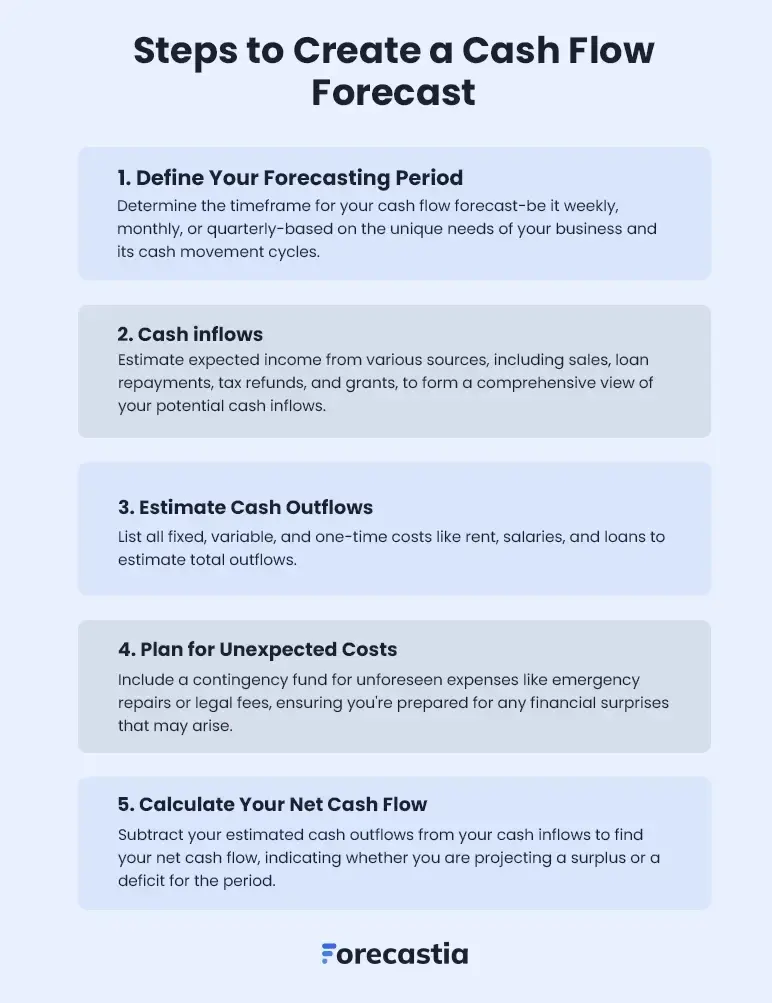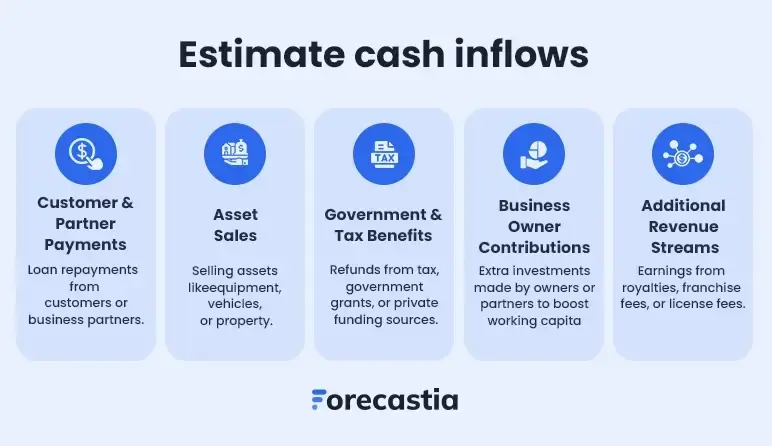Managing cash flow is probably one of the largest worries of business owners, and for good reason—when cash runs low businesses struggle to survive, making it one of the leading causes of failure.
And that’s why a cash flow forecast is one of the most critical elements of your business’s financial planning.
If you’re wondering, “How to forecast cash flow?” you’re asking the right track. Most business owners don't begin with a background in finance, but forecasting is simpler than you might think.
We’ll walk through the cash flow forecasting process in a way that actually makes sense. But first, let’s clear the basics with…
What is cash flow forecasting?
Cash forecasting is the process of predicting a business's cash inflows and outflows over a period. It means predicting the amount of operating cash a company has at a particular point. The information helps project future investments and maintain financial management.
So, what are the benefits of cash flow forecasts?
First, it helps you plan for major decisions. For example, if you need to hire staff, buy equipment, or expand, the forecast will show if you have more money or if negative cash flow could slow things down.
Second, banks and investors expect one. If you’re looking for funding, they’ll want to see how well you manage cash flow. But more than that, just having a cash forecast shows you’re serious about running a financially sound business.
For example: Spencergarret Fernandez, the CEO of SEOEchelon, avoided the risk of cash shortage by forecasting their revenue against payroll and marketing costs before hiring new SEO experts. This helped them expand smoothly without scrambling for funds.
Now you know what cash forecasting is, which is a solid first step. But just learning about it won’t get cash coming into your bank accounts (wouldn’t that be nice?).
That’s why it’s time to learn…
Preparing to forecast cash flow
Before actually preparing your own cash flow forecast, you need two things:
Gathering financial documents
An accurate cash flow forecast is only as good as the financial documents you use to build it. Collecting the correct data ensures more exact estimates and a smoother cash flow planning process. Here are the essential documents you’ll need:
- Financial statements that include income statements, balance sheets, and cash flow statements to track your working capital and cash flow.
- Sales tax reports and if any tax refunds are coming your way.
- Payroll documents that include wage and tax reports, payroll benefits, and deductions reports.
- Bank accounts listing opening balance, closing balance, and any loan payments to monitor bank payments and available working capital.
- Receivables and payables to compare to payments, utilities, and license fees.
Once you have these financial documents in order, you can start working on a cash flow projection. You can either do it manually in a spreadsheet or use a financial forecasting tool.
Spreadsheets give you complete control, but as your business scales, keeping up with it becomes time-consuming and increases the risk of negative cash flow figures. That brings us to…
Financial forecasting tool
An ideal financial forecasting tool (like Forecastia) can save time, reduce errors, and provide precise estimates by automating cash flow planning. When selecting one, consider the following features:
- Automation: Ensure the software can automatically sync with your accounting systems to keep your data current.
- Scenario planning: Look for tools that allow you to model various financial scenarios to plan ahead and prepare for potential risks.
- Integration: The tool should integrate with your existing accounting software for cohesive financial management.
- User-friendly interface: An intuitive interface ensures that users can navigate the tool for proper cash flow planning without extensive training.
You’ve done the groundwork—gathered documents, picked a method, and (hopefully) haven’t lost patience with spreadsheets. Now, it’s time to execute it.
How to forecast cash flow (quick steps)
Here is a step-by-step process of how to do a cash flow forecast:

Step 1: Decide how far you want to go
If you’ve been around for a while, past data can help you make more exact estimates. If you’re new, long-term forecasting might feel like making an educated guess…because, well, it is. But that’s okay! Your cash flow forecast should be a living document that updates as things change.
A weekly, monthly, or quarterly forecast is the way to go, depending on how often your business moves money.
- Weekly: For businesses with fast-moving transactions.
- Monthly: Ideal if you have steady non-sales income and manageable expenses.
- Quarterly: If your finances are predictable and you need to plan ahead.
Your own cash flow forecast should change as new information comes in. The goal is to ensure positive cash flow figures and avoid surprises.
Step 2: Estimate cash inflows
To forecast cash flow, you first need to figure out how much cash is coming in. While sales are a big part of that, they aren’t the only source of money. You might also have cash inflows from:
- Loan repayments that customers or business partners owe you.
- Selling assets like equipment or property.
- Refunds from tax, including GST rebates.
- Grants from government programs or private funds.
- Owner contributions where you or your partners invest more working capital.
- Other sources such as royalties, franchise fees, or license fees.

Once you know where your cash inflows are coming from, it’s time to forecast sales. If you have historical data, use past numbers to estimate how much revenue you’ll generate.
And just because you’ve made a sale doesn’t mean the cash is in hand. Look at your past payment cycles to determine when customers typically pay their invoices. If most of them take 30–60 days, factor that delay into your cash flow projection.
Step 3: Estimate cash outflows
Tracking both incoming and outgoing expenses holds the key to keeping your business units running cash flow smoothly. So, the next step should be listing everything your business spends money on.
Cash outflows typically fall into three categories:
- Fixed costs: Monthly expenses that don’t change, such as rent, salaries, and loan-based payments.
- Variable costs: Expenses that vary with business activity, including material costs, utilities, and contractor fees.
- One-time expenses: Large or irregular costs, like equipment purchases or tax settlements, can affect your cash flow estimates.
Once you’ve calculated to/tal expenses for each week or month column, compare them with your cash inflows to get an accurate net income.

Step 4: Incorporate unexpected expenses
No business is immune to surprises, and not planning for unexpected expenses can throw off your running cash flow fast, affecting business growth. A refund is great, but an unexpected repair bill? Not so much.
That’s why businesses, especially small business owners, must keep a cash buffer ready for emergencies like repairs, legal fees, or unexpected tax bills. A good target is 10–20% of your total expenses, or if your business has been around for a while, base it on past unexpected costs.
For instance, Delta Air Lines has attributed its survival through financial downturns to a well-maintained cash reserve. This financial safety net has helped the company weather disruptions without cutting back on essential operations.
Step 5: Organize it all and predict net cash flow
Now put everything together —cash inflows, expenses, and emergency buffers and calculate your net cash flow to know whether you’re bringing in more cash than you’re spending or if adjustments are needed.
The formula is simple: cash inflows – cash outflows = all the money you are left with.

If that sounds like too much work, Forecastia can do the math for you for all the cash you have. Just input your numbers, and it’ll calculate everything, track your bank payments, and show clear visual reports. You don’t have to manually check every week or month column. It’s all there for you.
Great! You’ve got your numbers in front of you. Let’s break down how to read the results and make smarter business decisions.
Analyze your cash flow for accuracy
You’ve done the math. Now figure out if your forecast is working for or against you.
If you’re seeing net income more than expenses, great! That means your business is operating with a positive cash flow figure. A negative cash flow figure suggests that more money is going out than coming in.
As EY highlights, businesses that fail to adapt their forecasts risk flawed scenario planning and financial vulnerability. Regularly reviewing your projections helps you avoid this risk.
Also, look for patterns to spot surplus and deficit cycles.
- Do you have months where expenses are too high?
- Are all your payments hitting at once?
If your operating cash flow is inconsistent, you might need to tweak your payment schedule, hold off on non-essential purchases, or bring in more money through promotions or financing options.
If your forecast is based on actual numbers, great! But what if you’re new and have no numbers, the next section is for you.
How do you forecast cash flow for a new business without historical data?
New companies still need to plan all the money they have, even without historical data. That’s fine as long as you approach it strategically.
First, research your market. Start by gathering as much information as you can about your industry and market trends. Look for industry reports, publications, or resources that provide insights into expected revenue growth, consumer behavior, and spending patterns.
Then, analyze your competitors. Look for businesses that are similar in size and scope to yours. Check their financials, if available, or study their pricing models, services, and customer base to estimate potential revenue streams.
Now, estimate revenue. Using the insights from your market and competitor research, make realistic revenue estimates. You can estimate how much you expect to sell based on competitors' performance or industry averages.
Next, identify your fixed costs. List all the expenses that are predictable and unchanging, such as rent, utilities, salaries, and insurance. These costs should be factored into your monthly cash flow forecast, as they will remain constant no matter your sales performance.
Estimate variable costs. Identify costs that will fluctuate based on sales, such as inventory, marketing expenses, or commissions. These costs will change as your business grows and sales volumes increase.
Monitor and adjust your cash flow forecast. As your business begins to operate, track your actual revenue and expenses to compare with your initial projections. Ensure to update your forecast regularly to reflect changes in your business environment or cash flow situation.
Use scenario analysis. Since your projections are based on estimates, it’s essential to use scenario analysis. You can use tools like Forecastia to model multiple projections—best-case, worst-case, and most likely-case scenario—to better understand the range of possible outcomes for your cash flow.
Keep refining your forecasts. As you gather real-time data from your operations, continue refining your projections. Regular updates are crucial to keeping your cash flow forecast accurate.
That’s how you forecast cash flow when you are new and don’t have historical data.
Regularly review and adjust your forecasts
Your forecast is like a work in progress, but it’s not a "set it and forget it" kind of thing. It might look great on paper, but how does it compare to real life?
Reviewing your numbers regularly keeps surprises to a minimum. If cash coming in isn’t what you predicted, or net income is dipping, it’s time to adjust. Maybe expenses ran higher than expected, or a big payment was delayed.
With a planned vs. actual feature, like the one in Forecastia, you can quickly spot discrepancies and adjust your forecasts. Keeping your data fresh ensures you’re always making smart decisions with all the cash moving through your business.
Download cash flow forecast template
A cash flow forecast template helps you see where your money is going, compare planned vs. actual, and figure out if you need to adjust before things get tight.
If you’re tired of doing math on the fly, our cash flow forecast template is here to help. It’s made for small business owners who want to track their net income and expenses without overcomplicating things.
Download it now—it’s free and easy to use.
Start preparing your forecast using AI
Keeping track of cash coming in and going out helps you make better business moves, avoid last-minute panics, and ensure you’re spending wisely.
Managing financial data manually isn’t easy. Spreadsheets work…for a while. Errors creep in, and suddenly, the numbers don’t add up. Keeping everything accurate takes constant effort, and let’s be honest, you have far more important things to do for your business growth.
That’s why smart businesses rely on AI forecasting tools like Forecastia. It tracks cash flows, manages invoices, and provides real-time insights, so you always have a clear picture of your finances. Just accurate, up-to-date financial data that helps you stay in control and make better business decisions.
Frequently Asked Questions
What tools can I use to create a cash flow forecast?
You can use tools like Forecastia and Upmetrics to create an efficient cash flow forecast. Forecastia automates cash flow tracking, provides real-time insights, and helps with scenario planning to prevent cash shortages. If you’re looking for a more comprehensive solution, Upmetrics helps align cash flow projections with your business strategy, ensuring accurate forecasting and even better financial planning.
How far into the future should I forecast my cash flow?
A cash flow forecast is typically prepared for a quarter or a year and broken down into weeks or months. However, during challenging cash flow periods, a daily forecast can provide better visibility.
What are the main components of a cash flow forecast?
- Cash inflows: Expected money from sales, loans, investments, grants, or interest during the forecast period.
- Cash outflows: Projected expenses like salaries, rent, utilities, inventory, loan repayments, and taxes.
- Net cash flow: The difference between inflows and outflows, showing whether the business is operating at a profit or loss.
How can seasonal variations affect my cash flow forecast?
Seasonal changes can cause fluctuations in cash inflows, with higher revenue in peak seasons and lower revenue in off-peak times. Without proper planning, this may lead to cash shortages during slow periods. Managing it requires inventory control, cost adjustments, and proactive financing strategies.

